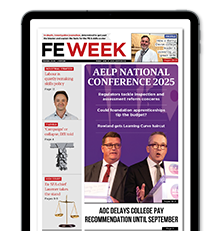The marketplace is changing rapidly, and it’s awash with new standards and providers. Stefano Capaldo explains how to sort the wheat from the chaff
Twelve months ago, the levy gave employers control of apprenticeship funding in England. While this is welcome in lots of ways, it has become increasingly difficult for employers to identify a training provider able to support the delivery of these skills – and much of this is down to their methods of procurement.
The move to employer-led standards from the old-style frameworks, the introduction of the register of apprenticeship training providers (RoATP) and key requirements such as 20 per cent off-the-job training have left many employers unsure what apprenticeship delivery now involves, and consequently with little idea of what good provision looks like.
Learning development and procurement teams have fallen back on what they view as reliable indicators of performance, or “cultural fit”, in competitive scenarios. The problem is that many of these indicators are no longer relevant, or even available.
On price, procurement teams still expect providers to reduce costs in return for higher delivery volumes – but this makes a mockery of the fee-cap structure, and quality is harder to achieve. Fee caps for standards are based on experienced providers’ estimates of the resources needed to deliver a quality programme; asking them to deliver for less significantly reduces the quality of the offer.
Employers need to identify additional benchmarks of quality that can be fulfilled by all those providers accepted onto RoATP
Recent months have seen a trend towards lower price-weighting in tenders. But when the government claims it wants higher-quality delivery and increased market diversity – particularly more SME providers – why ruin it by continuing to weight price at all?
Meanwhile, according to FE Week’s latest analysis, only around 25 per cent of current RoATP members have a grade one or two from Ofsted, and the majority of the remainder are unable to provide any grade at all.
Just 32 per cent of RoATP organisations were even in scope for inspection in Ofsted’s 2016/17 schedule, but in a tender exercise, an Ofsted grade is the first thing requested by employers to demonstrate quality. Providers without Ofsted ratings are asked to give “alternative evidence of quality” or (in some cases) are excluded from tendering altogether.
This vague requirement for alternative evidence is difficult for providers to fulfil and equally hard for procurement teams to score, as it relies on evaluators having a specialist knowledge of the sector and bidders providing comparable evidence.
Employers need to identify additional benchmarks of quality that can be fulfilled by all those providers accepted onto RoATP – ideally with the help of the ESFA, which set the original RoATP criteria.
Standards were introduced in 2015 and take an average of two years to complete. As a result very few providers have any substantial achievement data – and what data they do have only goes back one year.
In the digital sector, the British Computer Society’s statistics show that of 4,205 registered apprentices on digital standards in March, just 196 had undertaken end-point assessment.
Employers, however, are continuing to ask for results data going back at least three years.
Providers may substitute achievement data from previous frameworks, but given the differences in structure, content and assessment requirements between frameworks and standards, it’s unwise to assume that this is any guarantee.
So, when it’s time to find a provider to deliver your apprenticeships, what are the questions you should be asking during procurement?
1) Be as detailed as you can about your requirement. Do your homework on how many roles you need to fill, the specific role type, and whether this will be on a rolling basis or just a one-off. The clearer you can be about what you want from providers, the easier it is for them to show you how they fit your needs.
2) Don’t start with just one if you’re trying to build a large-scale programme. A single apprentice gives you no idea of how effectively the programme can be managed at scale, whether it is effective or even whether apprentices are right for your business – you may strike very lucky or unlucky with a particular hire. Aim to hire a cohort of at least ten, and ask the provider to demonstrate how they will help you monitor and evaluate the programme’s success to build a long-term apprenticeship culture.
3) Check the provider understands the importance of supporting the employer. They’re not just a ‘helpline’ for the apprentice; they should be supporting learning in the workplace by working with the learner, their manager and even their colleagues to show how the apprenticeship supports day-to-day business.
4) Ask them to demonstrate. Don’t rely on a written procurement to get what you want. Invite teams to presentation. Ask to speak to the delivery staff, not just the salespeople. Check that what they claim they can do is carried all the way through to the end of the process, and that they’ve got a good grasp of apprentice management basics such as safeguarding.
These questions will get to the heart of what’s important; the fundamental relationship between apprentice, employer and provider that (if handled correctly) will embed apprentices into ‘business as usual’ across the company.
Making these questions the foundation of your procurement process will help you identify the right provider for your needs, for every apprenticeship, in every sector, every time.
Stefano Capaldo is Managing Director of Firebrand Training








Your thoughts